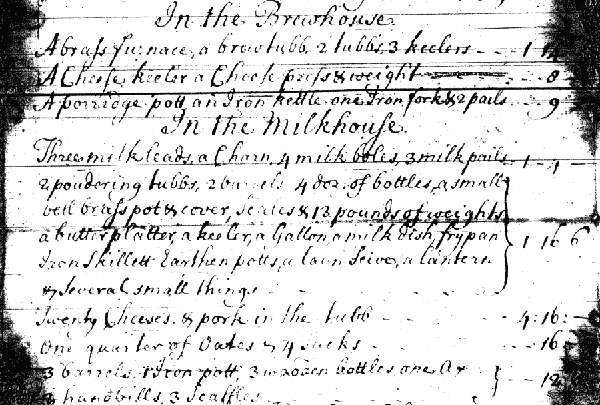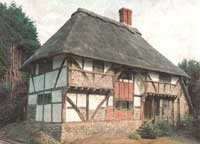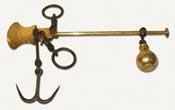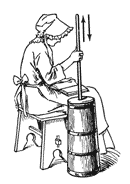Richard Hunnisett 1679-1732
Yeoman Farmer of Herstmonceux, Sussex
This essay explores the life of Richard Hunnisett, a small farmer in Sussex at the beginning of the 18th century, who happens to be my 6x great grandfather. The information comes from a variety of sources; principally from an inventory taken shortly after his death, but also church registers, tenancy agreements, and wills. Richard, himself, does not appear to have left a will but shortly after his death two men, probably neighbours, recorded a detailed inventory of all his movable possessions, for probate purposes. This gives a fascinating insight into the life of an 18th century yeoman farmer in Sussex.
Richard was the youngest son of Adrian, a reasonably well-off husbandman (known to have paid tax on 3 hearths in 1670), and he was baptised in Wartling on 27 December 1679. His father died when he was only 3 years old, following which his mother, Susanna, moved with her family of 6 sons and a six-month old daughter to Westham where she bought a house and where Richard was brought up. In 1702, by which time Richard was 22, his mother died and he inherited ten pounds, a pair of sheets and two pewter dishes. His sister Ann, just 20 years old, inherited the house and most of the estate. Perhaps her mother knew that Ann would never marry and this was her way of providing for her. Richard must have worked on farms in the area, learning the skills of animal husbandry and saving for the day when he could have his own farming business.
He married Ann Nye in Guestling on 28 April 1708 and they lived in Herstmonceux where they had four children baptised:
Mary
8 May 1709
Anne
22 Jun 1712
Susanna
27 Mar 1715
buried 24 Nov
Richard
12 Apr 1723
Richard became a farmer in his own right, and from 1714 was the tenant of 10 acres of marshland, approximately a fifth part of land known as 'The Tongs & Haynes', owned by the Herstmonceux Estate. This is on the edge of 'Pevensey Levels' and is prone to flooding in the winter. It may have been used for summer grazing, but was certainly a major source of hay, which Richard is known to have had at 'The Tongs'. From 1724 he was also the tenant of 'Walland', 11 acres of land again owned by the Herstmonceux estate. This was on higher ground and some two miles from 'The Tongs' and is likely to have been the main pasture for his herd of cattle. When Richard died both tenancies passed to his widow, Anne, and when she died to their only son Richard.
Richard was buried in Herstmonceux on 8 January 1732/3 aged 53. He left no will, but on 24 January an inventory was taken of his movable possessions which were valued at £232 3s 6d. A year later his sister Mary died, leaving 'the Testament and the Exposition' to Richard's widow Ann and further bequests to each of the children, including her 'house in Westham' to Richard, who was only 10 years old. It appears from this that at least some members of the family could read, and it is known that some signed their own wills, including Richard's mother, Susanna.

The inventory taken after his death has a wealth of information about how the family must have lived. It is divided into 8 sections; 6 rooms, linen and stock, and lists all his significant possessions, giving a value to each group of items.

Although we don't know where Richard's house was we do know from the inventory that it had 6 rooms; the kitchen, the brewhouse, the milkhouse and 3 chambers, two of which were used as bedrooms, the other as what we would probably now call a utility room. Vernacular housing of this period in Sussex was what is known as the Wealden house, a timber-framed building constructed around a central bay, originally with an open hearth, but by this time with a hearth under a canopy and probably with an additional chamber above the main bay. From the names given to the rooms in the inventory, Richard's house could well have been that type of house. Whether anyone else lived in the house is not known. It is possible that other relatives, servants or lodgers also lived there, but evidence of this has not been found.

The kitchen contains a typical assortment of furniture and kitchen implements, but a couple of things suggest that Richard was making a fairly good living as a farmer. The furniture is certainly more than just basic furniture; the oval table and the dresser for instance, and the clock and case may well have been the family's most prized possession. Clocks were still not very common at the beginning of the 18th century and would certainly have been a status symbol for a 'middling sort' family such as this.

The brewhouse was clearly used for the production of some sort of alcoholic beverages, possibly ale and almost certainly cider given the presence of the cheese press. This would have been used to extract juice from locally grown apples.
The milkhouse contained all the items you would expect to find in a dairy and confirms that the milk from the cows was also used to make butter and cheese. Pork from his pigs was also stored there.
The kitchen chamber and the brewhouse chamber contained their three beds, a table, some chairs and an assortment of chests, boxes and a trunk. When Anne died she left her 'second best bed bedstead curtains and coverings now in my kitchen chamber' to one daughter and another bed from the milkhouse chamber to her other daughter. Beds were clearly significant items of furniture and important enough to feature in many wills.
The outer chamber contained, among other things, two spinning wheels and a woollen wheel, which would have been used to produce yarn, which may have been turned into cloth by travelling weavers, or knitted into garments.
Linen was clearly important enough to warrant its own section in the inventory so must have been highly valued. Flax was grown to provide textile fibres and during the processing the short fibres (tow) were removed and used to make a course cloth. Tow sheets would therefore have been relatively cheap but probably more like blankets than today's sheets. Their two pairs of flaxen sheets would have been made of the finer quality cloth. Anne's will mentions 'Holland pillowcoats' which were made of a coarse linen fabric with a smooth surface, so called because it was first manufactured in Holland. The presence of napkins and table cloths again suggests a relatively prosperous 'middling sort' family.
His stock accounts for more than 80% of the total value of his movable possessions and emphasises the significance of his farming business. He was primarily a cattle farmer as can be seen from his herd of 26 cattle. His 6 cows were clearly producing 6 calves every year that were then grown on either to replenish his stock or to provide meat and dairy products. The inventory gives a good idea of how the value of a calf increased from about £1 in its first year to £6 or £8 when fully grown. Hay grown at 'the Tongs' was being used to supplement the animals feed during winter. Significantly he did not own a bull, so he must have hired the services of a neighbour's bull when required, just as some farmers do today.
He appears to have bred horses, as he owned a stone horse (a stallion), an old mare and two colts. He also had three other horses, probably used for transport, pulling carts and other farm work. Pigs were not a major part of his business, as although he had 2 hogs and 6 sheats (pigs under a year old) they were of relatively low value, and he did not have a boar or even a sow, so was not breeding them himself. Perhaps he bought piglets and fattened them up mainly for his own use.
The fact that he had 'money in pocket', £20 in the house, and nearly £9 owing to him also suggests that the business was flourishing and making a healthy profit. His widow continued to run the business and eventually it passed to their only son, Richard, who ran it until his own death, when it passed to his eldest son, Henry.
In conclusion then, we have a fairly clear picture of a prosperous 'middling sort' farmer who, having apparently built up his business from scratch, lived in a medium sized house, leased 2 fields, one for stock and one for hay, and made his living primarily from his herd of cattle. He also bred horses, fattened pigs, and brewed ale and cider. It is likely that the whole family was involved in the business, and the women also spun wool and maybe flax to provide yarn for weaving into cloth. He died at the age of 53, just short of his silver wedding anniversary.
Peter Hunnisett
Main Sources (all at East Sussex Record Office, Lewes):
Herstmonceux parish registers
Wartling parish registers
Westham parish registers
Herstmonceux & Wartling Tenement Analysis
Inventory for Richard Hunniset 1732
Will of Susanna Hunnisett 1699
Will of Mary Honeysett 1733
Will of Anne Honeysett 1744